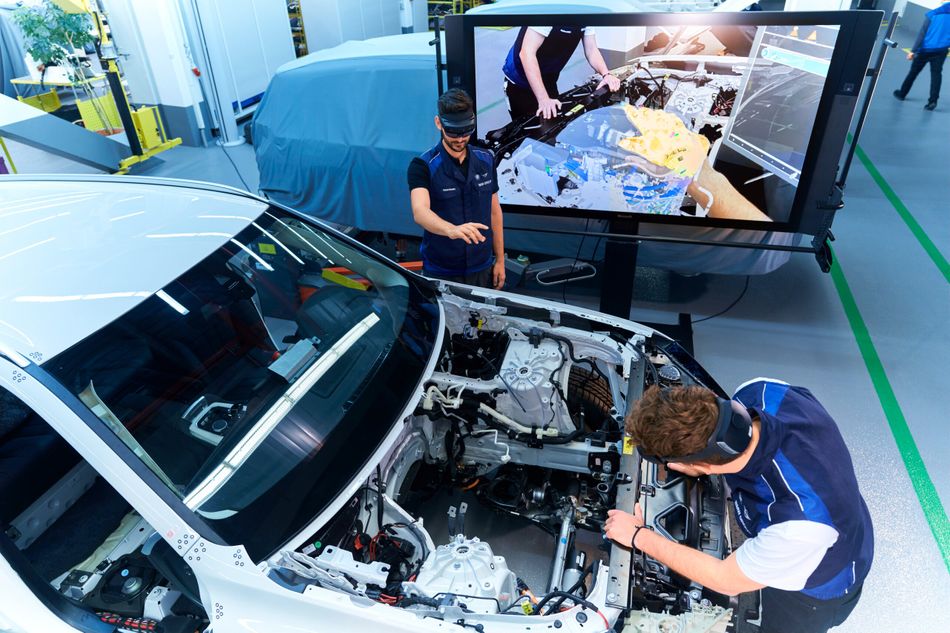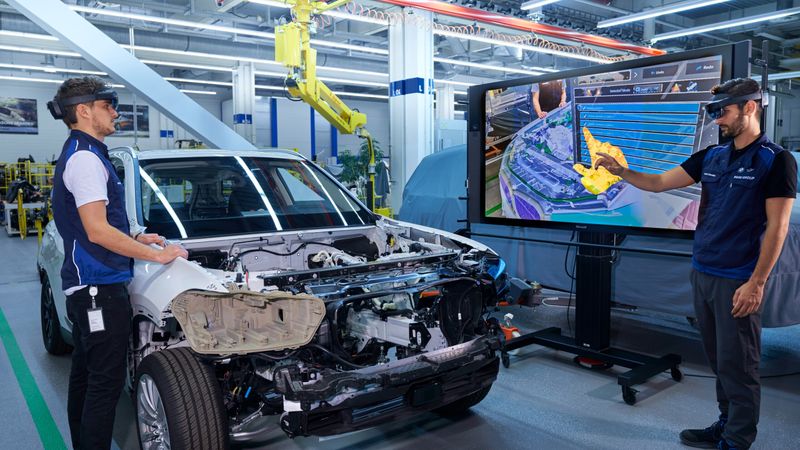BMW accelerates concept evaluations with industrial augmented reality and virtual reality
BMW Group has embraced augmented reality (AR) technology at its Munich headquarters to redefine automotive prototyping and concept evaluation
This article was discussed in our Next Byte podcast.
The full article will continue below.
New whitepaper: AR as a Booster for Industry 4.0,In the recent white paper from HoloLight, 'AR as a Booster for Industry 4.0,' you can explore the ways in which AR can have a significant transformative impact. Key highlights of the whitepaper:
Don't miss out on these valuable insights. Get your copy of the white paper now by filling out the simple form below. |
In a quest to redefine automotive prototyping and concept evaluation, BMW Group has embraced cutting-edge augmented reality (AR) technology at its Munich headquarters.
Running on Microsoft´s HoloLens 2 data goggles, the AR Engineering Software Hololight Space from Hololight allows real geometries—on a vehicle body, for instance – to be overlaid with true-to-scale holographic 3D models. Thus, a range of concept variants and assembly processes for future series vehicles can be assessed flexibly and cost-efficiently.
Vehicle Concepts Visualized in 3D
Vehicles and their components are visualized via the AR Software Hololight Space, which is linked to the BMW Group’s product data management system. The integrated remote rendering technology Hololight Stream enables streaming of the entire AR application. This means that the computing power does not have to come from the AR glasses themselves, but can be provided from the cloud or a high-performance, own controlled server. The data also never resides on the mobile device. A crucial security feature in the event of loss of the glasses or hacker attacks.
In the new workflow, the vehicle expert loads CAD files of components from the web-based database into the Hololight Space application. Using AR glasses, he can visualize the CAD data in 3D and their original size in a realistic environment. The AR application is controlled by hand, allowing direct interaction with virtual components.
With the AR application, a simple hand movement is enough to modify not only the size but also the position and angle of components. In addition, cross-sections can be created in real time to provide a view of the vehicle’s inner structures. Another advantage is the ability to work collaboratively. People at different locations around the world can now employ multi-user mode to team up and review designs and concepts together, as well as identify any errors.
Newly Gained Efficiency Factor with Augmented Reality
Using true-to-scale visualization and interaction with concepts and prototypes previously created in CAD programs, engineers can now immediately understand the accessibility, installation options, and visibility of relevant assembly points in complex systems. Above all, the superimposition of real geometry with holographic 3D models enables them to evaluate different variants of a concept in minutes. The BMW Group has thus achieved time savings of up to one year on vehicle module validation.

How Hololight Space can significantly benefit the automotive industry.
Prototyping and Design
Enhanced Visualization and Interaction: AR/VR technologies allow engineers and designers to create and interact with high-fidelity 3D models of vehicle components and assemblies. This capability enables a comprehensive evaluation of design elements, fit, and ergonomics without the need for physical prototypes. For example, designers can view and manipulate a digital twin of a car interior to assess user experience, identify potential issues, and make real-time adjustments. This not only accelerates the design process but also improves the overall quality and innovation of the vehicle design.
Time and Cost Savings
Reduction of Development Cycles: Implementing AR/VR in the automotive industry can significantly cut down the time required for vehicle concept validation. Traditional prototyping involves multiple iterations of physical models, which is both time-consuming and expensive. AR/VR allows for rapid iterations and instant feedback, facilitating quicker decision-making and reducing the overall development cycle. BMW, for instance, reported that using AR/VR reduced their concept validation time by up to a year, translating to substantial cost savings and a faster time-to-market for new models.
Enhanced Collaboration
Real-Time Remote Collaboration: AR/VR platforms enable seamless collaboration between geographically dispersed teams. Engineers, designers, and stakeholders can simultaneously access and interact with the same virtual prototype, discuss modifications, and make collective decisions in real time. This collaborative environment reduces the chances of miscommunication and errors that often occur in traditional workflows. Additionally, it fosters innovation by allowing diverse teams to contribute their expertise, ensuring that the final product benefits from a wide range of insights and perspectives.
Training and Maintenance
Immersive Training Experiences: AR/VR technologies provide highly immersive and interactive training modules for automotive technicians and assembly line workers. Trainees can practice assembly, repair, and maintenance tasks in a virtual environment that closely mimics real-world scenarios. This hands-on experience enhances learning and retention, making technicians more proficient and reducing the likelihood of mistakes. Furthermore, AR/VR training can be tailored to different skill levels, ensuring that all employees receive the appropriate level of instruction and can perform their tasks efficiently.
